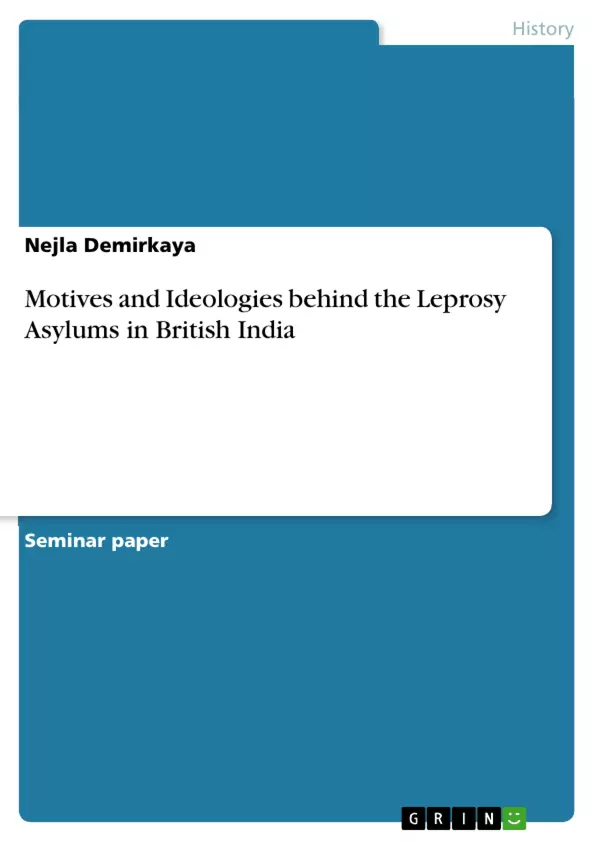Even to modern scientists, certain aspects of leprosy such as its exact mode of transmission and point of onset remain a matter of research. How much greater the confusion in regard to leprosy must have been in colonial times, when Western medicine as we know it today was just beginning to evolve, is easily understood by looking at the many different, even contradictory attitudes towards the disease and the ways of dealing with its sufferers in British India. Using the example of the main institutions designated for the housing and the care of India’s “lepers“, the leprosy asylums, the many different motives and ideologies partaking in the medical, public and political discourse on this ancient disease shall be identified and discussed, seeking to show the many interconnections between colonial interests, public pressure, medical perspectives and missionary agenda. Did colonial intervention root in medical or rather pragmatic considerations? What religious ideologies nurtured the wish for the confinement of “lepers“? How much influence did Indian public opinion exert on the way leprosy was dealt with? This paper thus attempts to reveal the inner workings of the colonial state by looking at the many agents taking part in public health decisions and policies.
Inhaltsverzeichnis (Table of Contents)
- Introduction
- The medical perspective
- The Indian perspective
- Religious background
- The “leper\" in public opinion
- The British perspective
- Governmental interests
- The missionary enterprise
- The leprosy asylum: Hospital or prison?
- Conclusion
Zielsetzung und Themenschwerpunkte (Objectives and Key Themes)
This paper aims to analyze the motives and ideologies behind the establishment of leprosy asylums in British India. It explores the interplay of medical perspectives, public pressure, colonial interests, and missionary agendas in shaping the public health policies concerning leprosy. The main objective is to uncover the complex dynamics and power relations at play in colonial India, highlighting the influence of different stakeholders in shaping the response to this ancient disease. Key themes of the paper include:- The changing medical understanding of leprosy and its transmission
- The role of religious beliefs and prejudices in shaping attitudes towards leprosy sufferers
- The impact of colonial policies and interventions on leprosy management in India
- The motivations behind the missionary enterprise and its role in leprosy care
- The social and political implications of the leprosy asylums, examining their nature as institutions of confinement and care
Zusammenfassung der Kapitel (Chapter Summaries)
- Introduction: The introduction sets the stage for the paper, discussing the enduring mystery surrounding leprosy and its transmission even in modern times. It underscores the complexities surrounding leprosy in colonial India, where evolving medical knowledge, diverse cultural beliefs, and colonial interests intertwined to shape the societal response to the disease.
- The medical perspective: This section explores the evolving medical understanding of leprosy throughout the 19th and early 20th centuries. It details how initial assumptions about the hereditary nature of the disease gradually shifted towards acknowledging its contagiousness. The discovery of the Mycobacterium leprae in 1874 and the subsequent increase in anxiety about contamination contributed to the growing demand for isolation and institutionalization of leprosy sufferers.
- The Indian perspective: This chapter delves into the Indian societal context, exploring the intersection of religious beliefs and public opinion concerning leprosy. It examines how traditional religious practices and social attitudes influenced the perception of leprosy sufferers and their social integration.
- The British perspective: This chapter focuses on the role of British colonial interests in shaping the response to leprosy in India. It analyzes the motivations behind government policies and the influence of missionary efforts on leprosy care.
- The leprosy asylum: Hospital or prison?: This chapter investigates the nature of the leprosy asylums as institutions of confinement and care. It explores the complex factors that shaped the asylum environment and the conditions experienced by the patients.
Schlüsselwörter (Keywords)
Leprosy, British India, colonialism, medical perspectives, public health, religious beliefs, social attitudes, missionary enterprise, leprosy asylums, confinement, segregation, care, colonial intervention.- Citation du texte
- Nejla Demirkaya (Auteur), 2014, Motives and Ideologies behind the Leprosy Asylums in British India, Munich, GRIN Verlag, https://www.grin.com/document/293784



